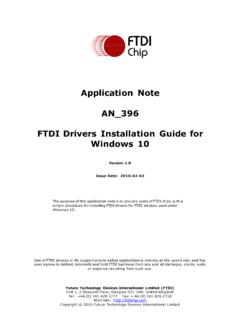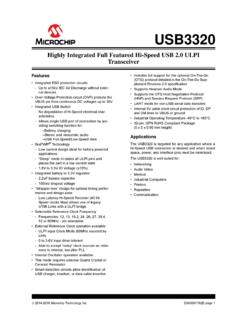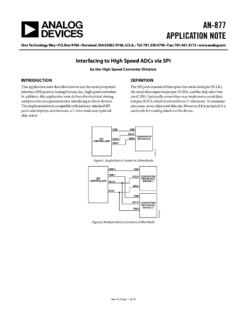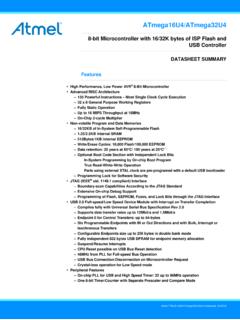Transcription of USB hardware and PCB guidelines using STM32 MCUs ...
1 IntroductionSTM32 microcontrollers include a group of products embedding a USB ( universal serial Bus) peripheral (see table below forapplicable products). Full-speed and high-speed operations are provided through embedded and/or external PHYs (physicallayers of the open system interconnection model).This application note gives an overview of the USB peripherals implemented on STM32 MCUs, and provides hardwareguidelines for PCB design, to ensure electrical compliance with the USB more details, refer to the USB or OTG sections in the reference manual related to the MCU used for your 1. Applicable productsTypeReferenceSeries, lines, part numbersMicrocontrollersComplete seriesSTM32F2 Series, STM32L1 Series, STM32L4+ SeriesComplete linesSTM32F102, STM32F103, STM32F105/107, STM32F373, STM32F401, STM32F405/415, STM32F407/417,STM32F411, STM32F412, STM32F413/423, STM32F427/437, STM32F429/439, STM32F446,STM32F469/479, STM32F7x2, STM32F7x3, STM32L0x2, STM32L0x3, STM32L4x2, STM32L4x3,STM32L4x5, STM32L4x6, STM32H743/753, STM32H750 Value lineSTM32F04xxxSTM32F042C4, STM32F042C6, STM32F042F4, STM32F042F6, STM32F042G4, STM32F042G6,STM32F042K4, STM32F042K6, STM32F042T4, STM32F042T6, STM32F048C6, STM32F048G6,STM32F048T6 STM32F072xxSTM32F072C8, STM32F072CB, STM32F072R8, STM32F072RB, STM32F072V8.
2 STM32F072 VBSTM32F078xxSTM32F078CB, STM32F078RB, STM32F078 VBSTM32F070xxSTM32F070C6, STM32F070CB, STM32F070F6, STM32F070 RBSTM32F302x6 STM32F302C6, STM32F302K6, STM32F302R6 STM32F302x8 STM32F302C8, STM32F302K8, STM32F302R8 STM32F302xBSTM32F302CB, STM32F302RB, STM32F302 VBSTM32F302xCSTM32F302CC, STM32F302RC, STM32F302 VCSTM32F302xDSTM32F302CD, STM32F302RD, STM32F302VD, STM32F302 ZDSTM32F302xESTM32F302RE, STM32F302VE, STM32F302 ZESTM32F303xBSTM32F303CB, STM32F303RB, STM32F303 VBSTM32F303xCSTM32F303CC, STM32F303RC, STM32F303 VCSTM32F303xDSTM32F303CD, STM32F303RD, STM32F303VD, STM32F303 ZDSTM32F303xESTM32F303RE, STM32F303VE, STM32F303 ZESTM32F74xxxSTM32F745IE, STM32F745IG, STM32F745VE, STM32F745VG, STM32F745ZE, STM32F745ZG,STM32F746BE, STM32F746BG, STM32F746IE, STM32F746IG, STM32F746NE, STM32F746NG,STM32F746VE, STM32F746VG, STM32F746ZE, STM32F746 ZGSTM32F756xxSTM32F756BG, STM32F756IG, STM32F756NG, STM32F756VG, STM32F756 ZGSTM32F76xxxSTM32F765BI, STM32F765IG, STM32F765II, STM32F765NG, STM32F765NI, STM32F765VG,STM32F765VI, STM32F765ZG, STM32F765ZI, STM32F767BG, STM32F767BI, STM32F767IG, STM32F767II,STM32F767NG, STM32F767NI, STM32F767VG, STM32F767VI, STM32F767ZG, STM32F767ZI,STM32F768AI, STM32F769AG, STM32F769AI, STM32F769BG, STM32F769BI, STM32F769IG,STM32F769II, STM32F769NG, STM32F769NI, STM32F769 SLSTM32F77xxxSTM32F777BI, STM32F777II, STM32F777NI, STM32F777VI, STM32F777ZI, STM32F778AI, STM32F779AI,STM32F779BI.
3 STM32F779II, STM32F779 NIUSB hardware and PCB guidelines using STM32 MCUsAN4879 Application noteAN4879 - Rev 4 - December 2018 For further information contact your local STMicroelectronics sales informationThe table below lists the main acronyms used in this document and their 2. List of abbreviations and acronymsAcronymDescriptionADPA ttach detection protocolBCPB attery charging detectionEMIE lectromagnetic interferenceESDE lectrostatic dischargeFSFull-speedHBMH uman body modelHSHigh-speedIECI nternational electrotechnical comissionLPMLink power managementLSLow-speedMCUM icrocontroller unit or microcontrollerOTGOn-the-goPCBP rinted circuit boardPHYP hysical layerSOFS tart of frameULPIUTMI + low-pin interfaceUSBU niversal serial busUTMIUSB transceiver macrocell interfaceThis document applies to STM32 microcontrollers which are based on Arm.
4 Arm is a registered trademark of Arm Limited (or its subsidiaries) in the US and/or information AN4879 - Rev 4page 2/252 USB on STM32 productsEach device with USB support embeds at least one of the following interfaces:A: USB FS device interfaceB: USB OTG FS, that is, USB FS device/host/OTG controller with on-chip FS PHYC: USB OTG HS, that is, USB FS/HS device/host/OTG controller, integrating the transceivers for full-speed operation, and featuring an ULPI for high-speed operation: an external PHY device connected to theULPI is : USB OTG HS controller with embedded on-chip HS PHYsThe following table lists the STM32 devices supporting an USB and describes which USB peripheral isimplemented in each of 3.
5 USB implementation in STM32 devicesSeries / lines or referencesSupported USB(1)Size ofdedicatedpacket bufferSRAMD edicatedVDDUSBE mbeddedpull-upresistor onUSB_DPlineABCDSTM32F0 SeriesSTM32F04x,STM32F072,STM32F078,STM3 2F070x6/BX---1 KbyteNoYesSTM32F1 SeriesSTM32F102 line,STM32F103 lineX---512 bytesNo-(2)STM32F105/107 KbytesNoYesSTM32F2 KbytesNoYes--X-4 KbytesNoYesSTM32F3 SeriesSTM32F302xB/C,STM32F303xB/C,STM32F 373 lineX---512 bytesNo-(2)STM32F302x6/8,STM32F302xD/E,S TM32F303xD/EX---1 KbyteNo-(2)STM32F4 Series(3)STM32F405/415 line,STM32F407/417 line,STM32F427/437 line,STM32F429/439 line,STM32F401 line,STM32F411 KbytesNoYes--X-4 KbytesNoYesSTM32F446 line,STM32F469/479 line,STM32F412 line,STM32F413/423 KbytesYesYes--X-4 KbytesYesYesSTM32F7 SeriesSTM32F74x,STM32F756,STM32F76x,STM3 2F77x,STM32F7x2 KbytesYesYes--X-4 KbytesYesYesSTM32F7x3 KbytesYesYes---X4 KbytesYesYesSTM32L0 SeriesSTM32L0x2 line,STM32L0x3 lineX---1 KbyteYesYesAN4879 USB on STM32 products AN4879 - Rev 4page 3/25 Series / lines or referencesSupported USB(1)
6 Size ofdedicatedpacket bufferSRAMD edicatedVDDUSBE mbeddedpull-upresistor onUSB_DPlineABCDSTM32L1 SeriesX---512 bytesNoYesSTM32L4 SeriesSTM32L4x2 line,STM32L4x3 lineX---1 KbyteYesYesSTM32L4x5 line,STM32L4x6 KbytesYesYesSTM32L4+ KbytesYesYesSTM32H7 SeriesSTM32H743/753 line,STM32H750 Value line-X(4)X-4 KbytesYes(5)Yes 1. X: To be compliant with the USB full-speed electrical specification, the USB_DP (D+) pin must be pulled up to a voltage inthe to V range with a k STM32F401/411/412/413/423 devices support only FS USB OTG HS device/host/OTG peripheral, supporting only full-speed Available through VDD50 USB and VDD33 USB pins. implementation on STM32 productsTable 4. USB implementation on STM32 mainstream productsFeature(1)STM32F070x6/BSTM32F072 STM32F078 STM32F04xSTM32F102 STM32F103 STM32F105/107 STM32F302xB/CSTM32F303xB/CSTM32F373 STM32F302x6/8 STM32F302xD/ESTM32F303xD/EUSB FS device interfaceUSB OTG FSUSB FS device interfaceCrystal-lessUSB-X-X-Number ofendpoints84(2)8 Host modechannels-8-Size ofdedicatedpacket bufferSRAM1 Kbyte(3)512 bytes(4) Kbytes(5)512 bytes(5)1 Kbytes(3)Pull-up resistoron k resistor should be addedLPMX-XBCDX-ADP- 1.
7 X: Bidirectional, including When the CAN peripheral is used, only the first 768 bytes are available to USB, the last 256 Bytes are used by The USB and CAN share a dedicated 512 bytes SRAM, and so they can be used in the same application but not at thesame The dedicated SRAM is used exclusively by the USB endpoints (not shared with any other peripheral). AN4879 USB implementation on STM32 products AN4879 - Rev 4page 4/25 Table 5. USB implementation on STM32 high-performance productsFeature(1)STM32F401 STM32F411 STM32F2x5/2x7 STM32F405/415 STM32F407/417 STM32F427/437 STM32F429/439 STM32F412 STM32F413/423 STM32F446 STM32F469 STM32F479 STM32F74xSTM32F756 STM32F76xSTM32F77xSTM32F7x2 STM32F730R/VSTM32F750 STM32F7x3 STM32F730Z/ISTM32H743/753 STM32H750 OTGFSOTGHSOTGFSOTGHSOTGFSOTGHSOTG FSOTGHSOTGFSOTGHSOTGFSOTGHSC rystal-lessUSB----------XXBidirectionale ndpoints(includingEP0)4-466-696999 Host modechannels8-81212-121612161616 Size ofdedicatedpacket bufferSRAM(2) availableto primaryI/Os viamuxing---X---X---XIntegratedPHYFS(3)- FS(3)FS(3)FS(3)-FS(3)FS(3)FS(3)HS(4)FS(3 )FS(3)LPM----X-XXXXXXBCD----X---X-XXADP- ----------- 1.
8 X: The dedicated SRAM is used exclusively by the USB endpoints (not shared with any other peripheral).3. Internal FS OTG PHY Internal HS OTG PHY support. AN4879 USB implementation on STM32 products AN4879 - Rev 4page 5/25 Table 6. USB implementation on STM32 ultra-low-power productsFeature(1)STM32L0x2 STM32L0x3 STM32L1xxSTM32L4x2 STM32L4x3 STM32L4x5 STM32L4x6 STM32L4 RxSTM32L4 SxUSB FS device interfaceUSB OTG FSCrystal-less USBX-XX(2)Number of endpoints86 (bidirectional)Host mode channels-12 Size of dedicatedpacket buffer SRAM(3)1 Kbytes (withadvanced FIFO control)Pull-up resistor onUSB_DP lineXXLPMXXBCDXXADP-X 1. X: Except for STM32L47x/L48x The dedicated SRAM is used exclusively by the USB endpoints (not shared with any other peripheral).
9 USB speedsIn Host mode, the USB OTG_FS supports full- and low-speed transfers, while in Device mode it only supports full-speed 7. Supported OTG_FS speedsMode(1)FS (12 Mbit/s)LS ( Mbit/s)HostXXDeviceX- 1. X: supported. In Host mode, the USB OTG_HS supports high-, full- and low-speed transfers, while in Device mode, it onlysupports high- and full-speed 8. Supported OTG_FS speedsMode(1)HS (480 Mbit/s)FS (12 Mbit/s)LS ( Mbit/s)HostXXXD eviceXX- 1. X: supported. AN4879 Supported USB speeds AN4879 - Rev 4page 6 against ESD and EMIP rotection against ESD and EMI is needed. The system should comply with both the JESD22-A114D (also knownas HBM) and the IEC 61000-4-2 HBM requires that the USB pins of the component device be tolerant up to 2 kV discharge, this is the case forSTM32 MCUs.
10 Refer to the figure and the table below for JESD22-A114D standard test waveform and classlevels. For more details on this topic refer to the document System Level ESD-expanded available 1. JESD22-A114D standard test waveformI rIpsmaxIps90% Ips10% IpsCurrent through a shorting wiretrtmax5 nanoseconds per division40 nanoseconds per divisionCurrent through a shorting wireTable 9. JESD22-A114D standard class levelsClassVoltage rangeCurrent rangeClass 0V < 250 VI < AClass 1A250 V < V < 500 A < I < AClass 1B500 V < V < 1000 A < I < AClass 1C1 kV < V < 2 A < I < AClass 22 kV < V < 4 A < I < AClass 3A1 kV < V < 8 A < I < AClass 3BV > 8 kVI > AThe system should also comply with the IEC 61000-4-2 standard on USB lines when they are connected to areceptacle.

















